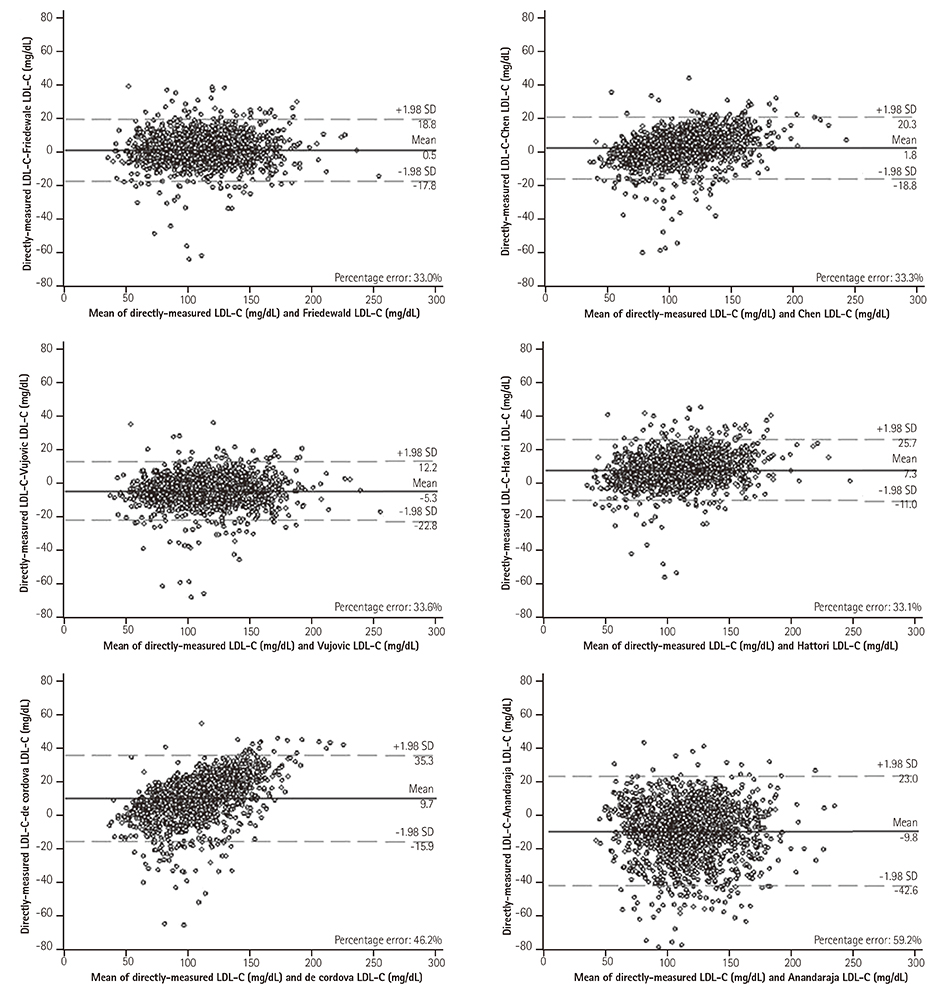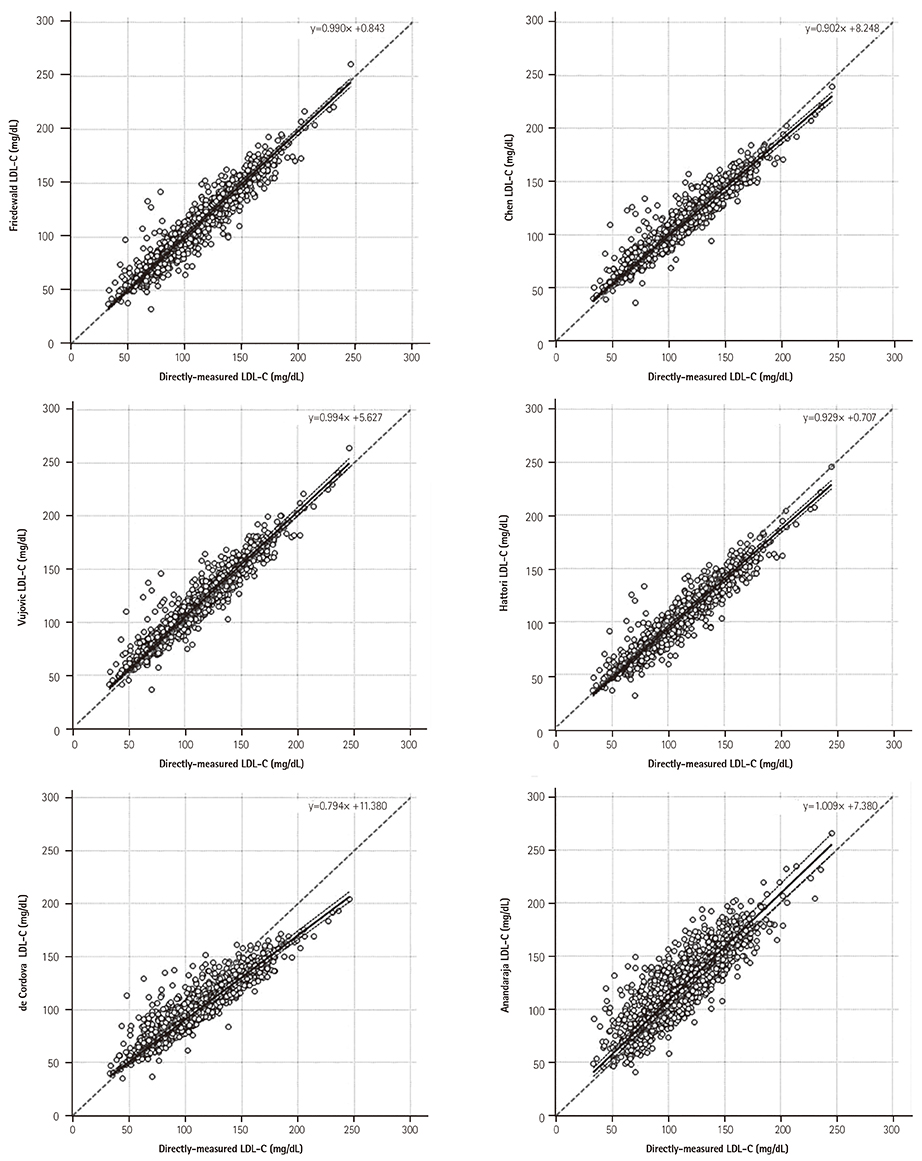Korean Circ J.
2016 Sep;46(5):688-698. 10.4070/kcj.2016.46.5.688.
Comparison of Formulas for Calculating Low-density Lipoprotein Cholesterol in General Population and High-risk Patients with Cardiovascular Disease
- Affiliations
-
- 1Department of Public Health, Yonsei University Graduate School, Seoul, Korea.
- 2Department of Preventive Medicine, Yonsei University College of Medicine, Seoul, Korea. hckim@yuhs.ac
- 3Cardiovascular and Metabolic Disease Etiology Research Center, Yonsei University College of Medicine, Seoul, Korea.
- KMID: 2389627
- DOI: http://doi.org/10.4070/kcj.2016.46.5.688
Abstract
- BACKGROUND AND OBJECTIVES
Low-density lipoprotein cholesterol (LDL-C), an established cardiovascular risk factor, can be generally determined by calculation from total cholesterol, high-density lipoprotein cholesterol, and triglyceride concentrations. The aim of this study was to compare LDL-C estimations using various formulas with directly measured LDL-C in a community-based group and hospital-based group among the Korean population.
SUBJECTS AND METHODS
A total of 1498 participants were classified into four groups according to triglyceride concentrations as follows: <100, 100-199, 200-299, and ≥300 mg/dL. LDL-C was calculated using the Friedewald, Chen, Vujovic, Hattori, de Cordova, and Anandaraja formulas and directly measured using a homogenous enzymatic method. Pearson's correlation coefficients, intraclass correlation coefficients (ICC), Passing & Bablok regression, and Bland-Altman plots were used to evaluate the performance of six formulas.
RESULTS
The Friedewald formula had the highest accuracy (ICC=0.977; 95% confidence interval 0.974-0.979) of all the triglyceride ranges, while the Vujovic formula had the highest accuracy (ICC=0.876; 98.75% confidence interval 0.668-0.951) in people with triglycerides ≥300 mg/dL. The mean difference was the lowest for the Friedewald formula (0.5 mg/dL) and the percentage error was the lowest for the Vujovic formula (30.2%). However, underestimation of the LDL-C formulas increased with triglyceride concentrations.
CONCLUSION
The accuracy of the LDL-C formulas varied considerably with differences in triglyceride concentrations. The Friedewald formula outperformed other formulas for estimating LDL-C against a direct measurement and the Vujovic formula was suitable for hypertriglyceridemic samples; it could be used as an alternative cost-effective tool to measure LDL-C when the direct measurement cannot be afforded.
MeSH Terms
Figure
Cited by 1 articles
-
Cohort Profile: The Cardiovascular and Metabolic Diseases Etiology Research Center Cohort in Korea
Jee-Seon Shim, Bo Mi Song, Jung Hyun Lee, Seung Won Lee, Ji Hye Park, Dong Phil Choi, Myung Ha Lee, Kyoung Hwa Ha, Dae Jung Kim, Sungha Park, Won-Woo Lee, Yoosik Youm, Eui-Cheol Shin, Hyeon Chang Kim
Yonsei Med J. 2019;60(8):804-810. doi: 10.3349/ymj.2019.60.8.804.
Reference
-
1. Expert Panel on Detection, Evaluation, and Treatment of High Blood Cholesterol in Adults. Executive summary of the third report of the National Cholesterol Education Program (NCEP) expert panel on Detection, Evaluation, and Treatment of high blood cholesterol in adults (Adult Treatment Panel III). JAMA. 2001; 285:2486–2497.2. European Association for Cardiovascular Prevention & Rehabilitation. Reiner Z, Catapano AL, et al. ESC/EAS Guidelines for the management of dyslipidaemias: the Task Force for the management of dyslipidaemias of the European Society of Cardiology (ESC) and the European Atherosclerosis Society (EAS). Eur Heart J. 2011; 32:1769–1818.3. Son JI, Chin SO, Woo JT. The Committee for Developing Treatment Guidelines for Dyslipidemia, Korean Society of Lipidology and Atherosclerosis (KSLA). Treatment guidelines for dyslipidemia: summary of the expanded second version. J Lipid Atheroscler. 2012; 1:45–59.4. Bachorik PS, Ross JW. National Cholesterol Education Program recommendations for measurement of low-density lipoprotein cholesterol: executive summary. The National Cholesterol Education Program Working Group on Lipoprotein Measurement. Clin Chem. 1995; 41:1414–1420.5. Anandaraja S, Narang R, Godeswar R, Laksmy R, Talwar KK. Low-density lipoprotein cholesterol estimation by a new formula in Indian population. Int J Cardiol. 2005; 102:117–120.6. Anwar M, Khan DA, Khan FA. Comparison of Friedewald formula and modified Friedewald formula with direct homogeneous assay for low density lipoprotein cholesterol estimation. J Coll Physicians Surg Pak. 2014; 24:8–12.7. Chen Y, Zhang X, Pan B, et al. Short paper A modified formula for calculating low-density lipoprotein cholesterol values. Lipids Health Dis. 2010; 9:52.8. de Cordova CM, de Cordova MM. A new accurate, simple formula for LDL-cholesterol estimation based on directly measured blood lipids from a large cohort. Ann Clin Biochem. 2013; 50(Pt 1):13–19.9. Friedewald WT, Levy RI, Fredrickson DS. Estimation of the concentration of low-density lipoprotein cholesterol in plasma, without use of the preparative ultracentrifuge. Clin Chem. 1972; 18:499–502.10. Hattori Y, Suzuki M, Tsushima M, et al. Development of approximate formula for LDL-chol, LDL-apo B and LDL-chol/LDL-apo B as indices of hyperapobetalipoproteinemia and small dense LDL. Atherosclerosis. 1998; 138:289–299.11. Vujovic A, Kotur-Stevuljevic J, Spasic S, et al. Evaluation of different formulas for LDL-C calculation. Lipids Health Dis. 2010; 9:27.12. Scharnagl H, Nauck M, Wieland H, März W. The Friedewald formula underestimates LDL cholesterol at low concentrations. Clin Chem Lab Med. 2001; 39:426–431.13. Martin SS, Blaha MJ, Elshazly MB, et al. Comparison of a novel method vs the Friedewald equation for estimating low-density lipoprotein cholesterol levels from the standard lipid profile. JAMA. 2013; 310:2061–2068.14. Martins J, Olorunju SA, Murray LM, Pillay TS. Comparison of equations for the calculation of LDL-cholesterol in hospitalized patients. Clin Chim Acta. 2015; 444:137–142.15. Rubiés-Prat J, Reverter JL, Sentí M, et al. Calculated low-density lipoprotein cholesterol should not be used for management of lipoprotein abnormalities in patients with diabetes mellitus. Diabetes Care. 1993; 16:1081–1086.16. Choi SY, Park HE, Kim MK, Shin CS, Cho SH, Oh BH. Difference between calculated and direct-measured low-density lipoprotein cholesterol in subjects with diabetes mellitus or taking lipid-lowering medications. J Clin Lipidol. 2012; 6:114–120.17. Oliveira MJ, van Deventer HE, Bachmann LM, et al. Evaluation of four different equations for calculating LDL-C with eight different direct HDL-C assays. Clin Chim Acta. 2013; 423:135–140.18. Kapoor R, Chakraborty M, Singh N. A leap above Friedewald formula for calculation of low-density lipoprotein-cholesterol. J Lab Physicians. 2015; 7:11–16.19. Goodman DS, Hulley SB, Clark LT, et al. Report of the National Cholesterol Education Program Expert Panel on detection, evaluation, and treatment of high blood cholesterol in adults. Arch Intern Med. 1988; 148:36–69.20. Bland JM, Altman DG. Statistical methods for assessing agreement between two methods of clinical measurement. Lancet. 1986; 1:307–310.21. Hanneman SK. Design, analysis and interpretation of method-comparison studies. AACN Adv Crit Care. 2008; 19:223–234.22. Passing H, Bablok W. A new biometrical procedure for testing the equality of measurements from two different analytical methods. Application of linear regression procedures for method comparison studies in clinical chemistry, Part I. J Clin Chem Clin Biochem. 1983; 21:709–720.23. Bilic-Zulle L. Comparison of methods: Passing and Bablok regression. Biochem Med (Zagreb). 2011; 21:49–52.24. Hwang YC, Ahn HY, Jeong IK, Ahn KJ, Chung HY. Optimal range of triglyceride values to estimate serum low density lipoprotein cholesterol concentration in Korean adults: the Korea National Health and Nutrition Examination Survey, 2009. J Korean Med Sci. 2012; 27:1530–1535.25. Tanno K, Okamura T, Ohsawa M, et al. Comparison of low-density lipoprotein cholesterol concentrations measured by a direct homogeneous assay and by the Friedewald formula in a large community population. Clin Chim Acta. 2010; 411:1774–1780.26. Onyenekwu CP, Hoffmann M, Smit F, Matsha TE, Erasmus RT. Comparison of LDL-cholesterol estimate using the Friedewald formula and the newly proposed de Cordova formula with a directly measured LDL-cholesterol in a healthy South African population. Ann Clin Biochem. 2014; 51(Pt 6):672–679.27. Miller WG, Waymack PP, Anderson FP, Ethridge SF, Jayne EC. Performance of four homogeneous direct methods for LDL-cholesterol. Clin Chem. 2002; 48:489–498.
- Full Text Links
- Actions
-
Cited
- CITED
-
- Close
- Share
- Similar articles
-
- Changes in the Serum Level of High Density Lipoprotein-cholesterol after Smoking Cessation among Adult Men
- Residual Cardiovascular Risk Remains Despite of Statin Treatment: Importance of High-Density Lipoprotein Cholesterol
- High Density Lipoprotein Cholesterol Comes of Age
- Predictors of Serum Low-Density Lipoprotein Cholesterol Level in Postmenopausal Women
- New Therapeutic Approaches to the Treatment of Dyslipidemia 2: LDL-C and Lp(a)




